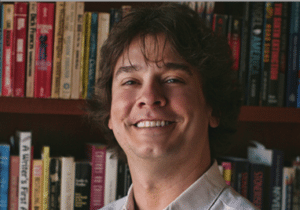Editing books since 1992 and in charge of TED’s editorial operations since 1998.
What led you to start working in digital/media publishing?
I became a professional book editor in 1992, back before ebooks, digital print, and online publishing had really taken off. Back then most of my work was with authors seeking traditional book deals for novels and narrative nonfiction. Once the editing was complete, the path to publication usually involved first landing a literary agent, then securing a publisher, and then (in the happy event that those first two things happened in a fiercely competitive and oversaturated marketplace) waiting as much as two years for the book to be released in print.
While my company was able to help many authors be successful on this path, the process was not without its frustrations. This was especially true for authors writing outside the conventions of established genres or on topics of interest to smaller, niche readerships–authors with good books that were better suited for small press or indie publishing, which was just starting to change for the better thanks to advances in digital technology.
My interest in digital publishing started with the release of Amazon’s first generation of the Kindle e-book reader and with the infancy of amazon.com’s innovative online retail platform.
Within a few short years, e-books began selling well and advance in “print on demand” digital printing had changed the entire landscape of self-publishing, which was in turn quickly becoming a more respectable (and practical) option for authors who wanted to publish outside the “permissions model” of traditional book publishing.
Now authors could have their small press or independently published books available on amazon.com right alongside national bestsellers. Now books could be put into production in a matter of weeks rather than years. Gone went the days when you had to buy 5,000 offset-printed books just to bring the per-copy cost low enough to make the cover price attractive to readers. Gone was the waste, cost, and logistical challenges of producing books before they were ordered or even had a guaranteed buyer.
The price for books produced digitally went down, the production quality went up, and innovative companies like Ingram Spark and Amazon began offering reliable infrastructure for production, marketing and order fulfillment. This empowered self-publishing authors and small, independent presses publishing works digitally like never before.
The trajectory of the publishing marketplace since has given us a keen appreciation for the advantages of digital publishing and we now specialize in helping authors who go this route do so at a very high level.
What does a typical day look like for you?
Lots of reading manuscripts and talking to authors about their creative vision and publishing objectives. Lots of communication with my staff of 15 editors on assignments ranging from manuscript critique to developmental editing to line and copy editing, all to ready books for traditional, digital print, e-book publication.
What’s your work setup look like?
Microsoft Word is a mainstay of any editor’s work setup, as that’s what most authors use to write their manuscripts. We also use a project management tool called 5pm to help editors field assignments and stay on top of deadlines. Once a manuscript is ready for layout and e-book formatting, Adobe tools such as InDesign are a big part of the process. We also use Google apps for cloud-based collaboration on documents, spreadsheets, etc..
What do you do or go to get inspired?
I read the work of authors I admire. Most commercial fiction and nonfiction along the lines of what we develop and edit here at The Editorial Department, LLC.
What’s your favorite piece of writing or quote?
The Sellout, by Paul Beatty, is one of the most memorable and engaging books I have ever read. It’s a scathing, sad, and often hilarious work of social commentary from a talented author who’s not afraid to take risks. As for a quote, “All things in moderation, including moderation” always stuck with me.
Content from our partners
What is the passionate problem you are tackling at the moment?
Staying on top of changes in a rapidly evolving publishing marketplace and adapting our services to meet the needs of authors who work in this arena.
Is there a product, solution or tool that makes you think it is a good design for your digital publishing efforts?
There’s no single solution. But together Microsoft Word and Adobe InDesign make a powerful combination for writing, editing, and designing books.
Any advice for ambitious digital publishing and media professionals just starting out?
Recognize that we live in a period of unprecedented proliferation of the published word–a glut of new content hitting the market every day and attention spans spread thinner than ever before. Put quality of concept, execution, and writing first in anything you publish.












